General definition of off-ball screen
An off-ball screen consists of action that occurs when at least one offensive player sets a screen for another offensive player who does not have current possession of the basketball, ultimately to create a potential scoring opportunity near the basket or near perimeter areas of the court.
Types of off-ball screens
These are examples of the different types of off-ball screens that could be set and utilized by offensive players.
It should also be mentioned that the offensive players on the following diagrams within this section are simply denoted via numbers such as 1, 2, or 3, and do not have specified roles at this time.
Back screen
The back screen occurs when an offensive player sets an off-ball screen directly behind a defender and afterwards, another offensive player could then use that screen to get open, especially near the basket.
The diagrams in the subsections below demonstrate basic examples of the back screen.
Example: Basic back screen 1
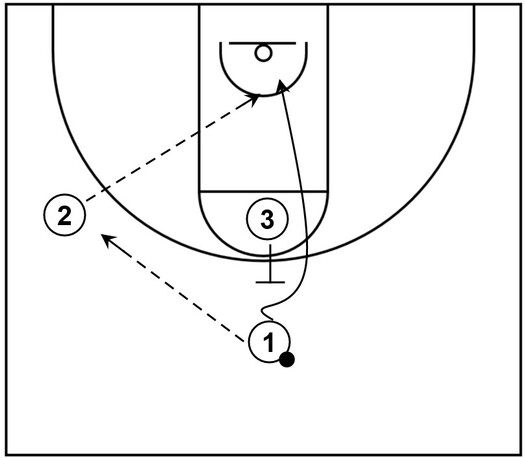
In terms of the basic setup: 1 is at the top with possession of the basketball, represented by the black dot; 2 is on the left side wing; 3 is at the middle of the high post area.
To begin, 2 receives the ball from 1, indicated by the dotted arrow. Next, 1 cuts to the basket via a back screen set by 3.
Following that, 1 could receive the ball again from 2 and score via a layup at the rim.
Example: Basic back screen 2
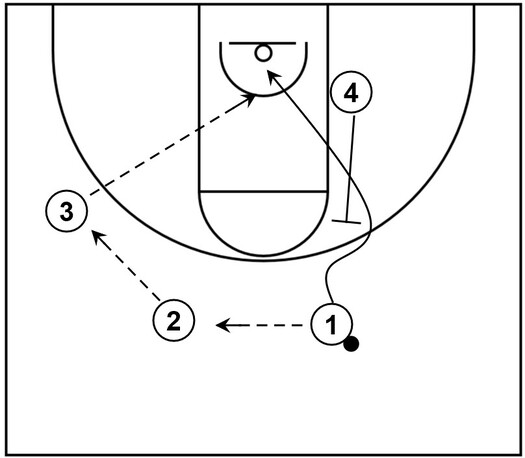
This is another example of a basic back screen. As it relates to the setup: 1 is in the right slot with possession of the ball; 2 is in the left slot; 3 is near the left side wing area; 4 initially occupies the right side low post area.
To start, 2 receives the ball from 1 and then 3 receives it from 2. As that happens, 4 lifts up towards the right side high post elbow area to set a back screen.
1 uses that screen, cuts to the basket, receives the ball from 3, and scores at the rim via a layup.
Cross screen
The cross screen occurs when one offensive player sets a screen, typically near the middle of the lane, or in some instances, in the center of the high post area.
The diagrams in the subsections below demonstrate basic examples of the cross screen set by an offensive player.
Example: Basic cross screen 1
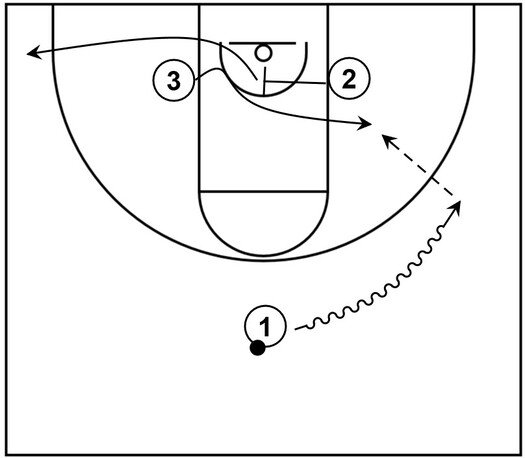
In terms of the setup: 1 is at the top in possession of the basketball; 2 fills the right side low post area; 3 occupies the left side low post area.
1 begins by dribbling towards the vacant right side wing area, indicated by the wavy arrow.
As that happens, 2 steps into the lane to set a cross screen. 3 utilizes that screen and cuts across the lane to the right side low post area while 2 continues cutting towards the left side corner.
Afterwards, 3 receives the ball from 1 and attempts to score around the basket by way of a layup or low post move.
Example: Basic cross screen 2
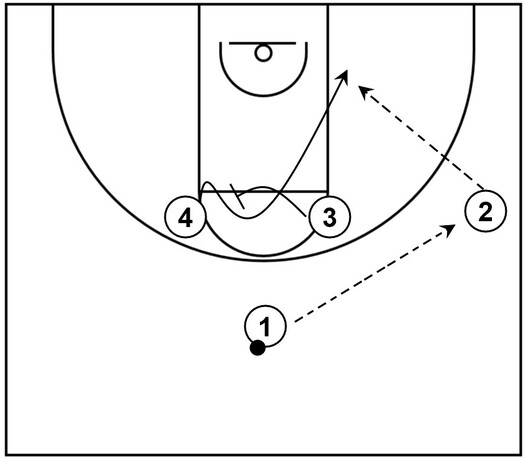
This is an example of a cross screen variation near the high post area. For the setup: 1 is at the top with possession of the basketball; 2 occupies the right side wing area; 3 and 4 fill the right side and left side high post elbow areas respectively.
To begin the basic action, 2 receives the ball from 1. Next, 3 cuts across the high post to set a cross screen. 4 uses that screen and then slices through the lane to the right side low post area.
Following that, 4 receives the ball from 2 and has the opportunity to score around the basket via a low post move and/or close-range shot.
Down screen
The down screen occurs when an offensive player sets an off-ball screen while facing the baseline or the basket.
After that, another offensive player could use that screen and cut towards the perimeter areas of the court such as the wings.
Moreover, there are two variations of the standard down screen known as the pin down screen, which is set near the lane adjacent to the basket and the wide pin down screen, which is set near the corner.
The diagrams within the subsections below showcase various examples of the down screen.
Example: Basic down screen 1
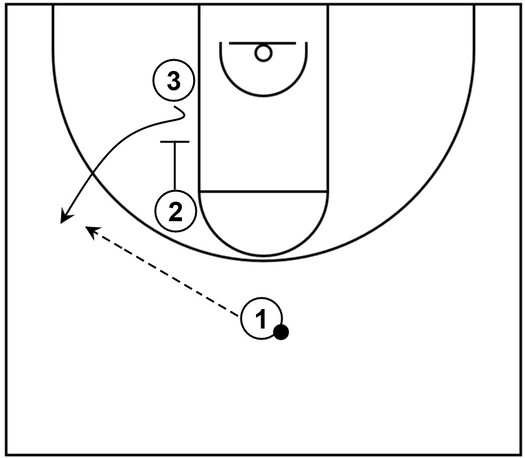
This is a basic example of a down screen in basketball. In relation to the offensive setup; 1 is at the top in possession of the ball; 2 initially begins near the left side high post elbow area; 3 occupies the left side low post area.
To start the simple action, 2 cuts toward the direction of the baseline to set a down screen. 3 uses that screen to get open near the left side wing area.
From there, 3 receives the ball from 1 and could potentially take a jump shot or drive to the rim.
Example: Basic down screen 2
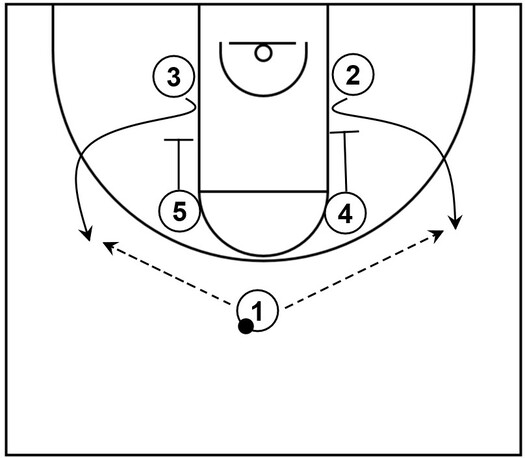
This is another example of basic down screens at play. For the setup: 1 is at the top in possession of the ball; 2 and 3 occupy the right side and left side low post areas respectively; 4 and 5 fill the right side and left side high post elbow areas respectively.
For the simple action, 2 and 3 cut to the adjacent wing areas by utilizing the down screens that are set by 4 and 5. From there, 2 or 3 could receive the ball from 1 and potentially take open three-point shots.
Example: Pin down screen 1
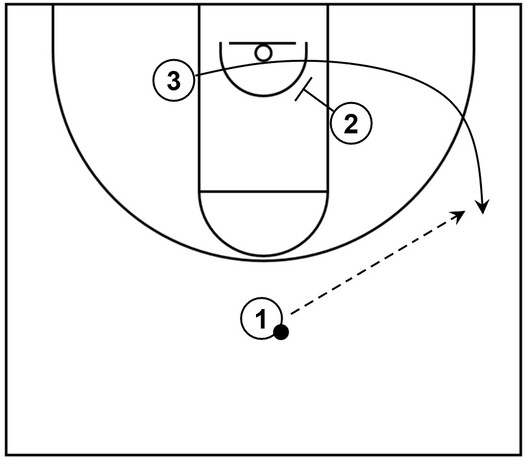
This is an example of a pin down screen. For the setup; 1 is at the top with possession of the ball; 2 is near the mid-post area between the high and low post; 3 occupies the left side low post area.
To start the simple action, 2 sets a pin down screen facing the general direction of the basket, either slightly within the lane or just outside of the lane line.
Next, 3 uses that screen to cut and get open near the right side wing area. Following that, 3 receives the ball from 1 and has the option to take the three-point shot.
Example: Pin down screen 2 | Floppy
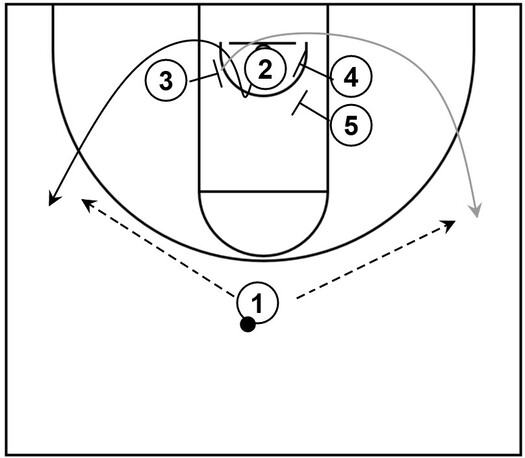
Here is a variation of the previous pin down screen example. In this case, there is a single pin down screen on one side of the lane line and a double pin down screen on the opposite side.
This single/double screening sequence is typically referred to as floppy action or in some cases, a floppy screen or floppy set.
In relation to the on-court setup: 1 is at the top with possession of the ball; 2 is under the basket; 3 is near the left side lower lane area; 4 and 5 are near the right side mid and lower lane areas.
To begin, 2 has the option to use either the single pin down screen from 3 or the double pin down screen by 4 and 5.
For this case, 2 decides to use the single screen and therefore cuts to the left side wing. Also, since 2 went for the single pin down screen, that gives 3 an opportunity to use the double pin down screen, which is represented by the gray arrow towards the right side wing area.
Moreover, the sequence of events that involved 2 and 3 in particular is known as screen the screener action. Basically, 3 set a screen and then received a screen from additional players on the court.
At any rate, after the screens and cutting occurs, 2 or 3 could receive the ball from 1, which could then result in potential three-point shot opportunities.
Example: Wide pin down screen
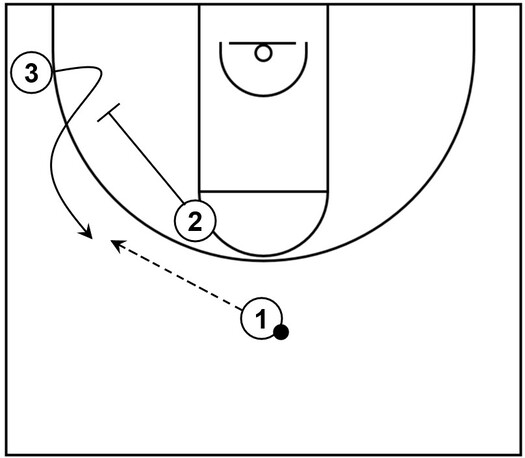
This is an example of a wide pin down screen, sometimes called a corner pin down screen.
For the setup: 1 is at the top; 2 is near the left side high post elbow area; 3 occupies the left side corner.
From there, 2 cuts toward the left side corner to set a wide pin down screen. 3 uses that screen to get open near the left side wing area.
Afterwards, 3 receives the ball from 2 and could potentially take the three-point shot.
Elevator screen
The elevator screen comprises action that occurs when an off-ball offensive player cuts through a small gap between two additional parallel players who then execute the elevator screen by immediately closing the gap before a defender has an opportunity to cut through it themselves.
The diagram within the subsection below demonstrates an example of the elevator screen.
Example: Basic elevator screen 1

Here is an example of a basic elevator screen. In terms of the initial setup: 1 is at the top with possession of the ball; 2 occupies the right side low post area; 3 and 4 are near the left side and right side high post elbow areas respectively.
To begin, 1 makes a dribble entry towards the right side wing and as that happens, 2 cuts to the top via the elevator screen set by 3 and 4.
From there, 2 receives the ball from 1 and has the opportunity to take the open three-point shot.
Example: Basic elevator screen 2
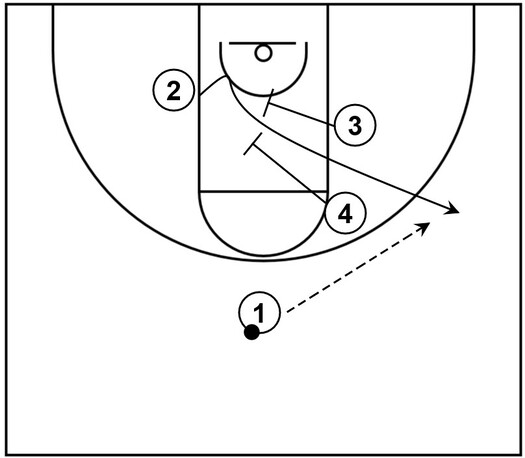
This is another example of the elevator screen. However, this time, the offensive player will cut towards the wing instead of the top.
In terms of the setup: 1 is at the top; 2 fills the left side low post area; 3 is near the right side mid-post; 4 is near the right side high post elbow area.
To start the action, 3 and 4 cut towards the middle of the lane to set the elevator screen.
2 uses that screen by cutting in between 3 and 4, going towards the right side wing.
Afterwards, 2 receives the ball from 1 and has the opportunity to take the open three-point shot.
Flare screen
The flare screen occurs when an offensive player cuts away from the basketball to utilize an off-ball screen set by another offensive player.
The diagram within the subsection below demonstrates a basic example of the flare screen.
Example: Basic flare screen
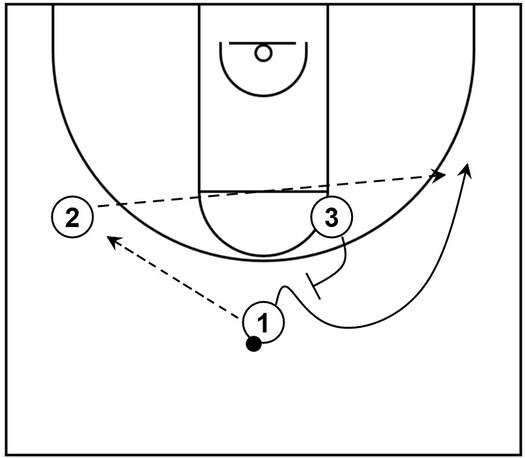
For the setup: 1 is at the top in possession of the ball; 2 occupies the left side wing area; 3 is near the right side high post elbow area.
To start, 2 receives the ball from 1. Afterwards, 1 cuts across to the right side wing area by way of the flare screen set by 3.
Following that, 1 receives the ball from 2 via a skip pass and has the opportunity to take the three-point shot or attack the rim.
Flex screen
The flex screen occurs when an offensive player moves toward the general area of the court that is between the low post area and the adjacent corner while facing the sideline to set a screen for another offensive player, who is usually near that same adjacent corner.
It should be noted as well that the flex screen is also a type of back screen. However, it is primarily derived from the Flex offense, hence the name.
The diagram in the subsection below showcases a basic example of the flex screen within offensive action.
Example: Basic flex screen
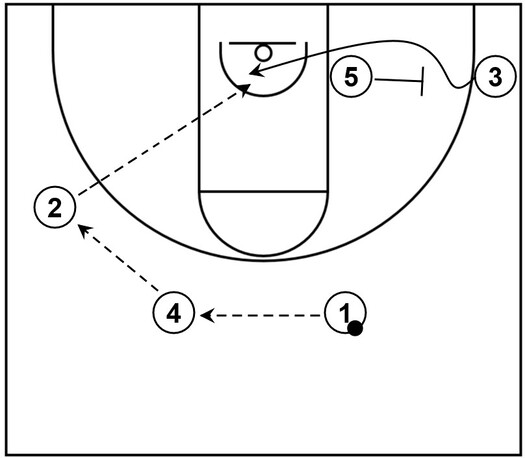
In relation to the setup: 1 and 4 fill the right and left slots respectively; 2 occupies the left side wing area; 3 is in the right corner; 5 fills the right side low post area.
To begin the action, 4 receives the ball from 1 and then 2 receives it from 4. As those passes occur, 3 cuts to the basket (also sometimes referred to as a flex cut) by way of the flex screen set by 5.
After that, 3 can receive the ball from 2 and score via a layup.
Hammer screen
The hammer screen occurs when an offensive player sets an off-ball screen for another offensive player who uses the screen and cuts to the adjacent corner.
The hammer screen could also be considered a type of back screen or perhaps even a flare screen.
However, it is also derived from the hammer set play, hence its name.
The diagram in the subsection below shows an example of the hammer screen action.
Example: Basic hammer screen
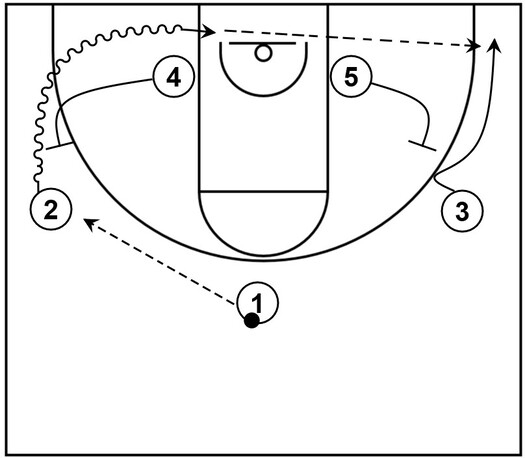
For the initial setup: 1 is at the top with possession of the basketball; 2 and 3 fill the left side and right side wing areas, respectively; 4 and 5 occupy the left side and right side low post areas, respectively.
At the start of the action, 2 receives the ball from 1. Next, 4 moves toward the left side wing area to set a type of on-ball screen known as a step-up screen.
2 uses that screen and dribbles toward the baseline area, mainly looking to attack the basket for a possible layup.
However, as that happens on the strong side, 5 moves toward the right side wing area set a hammer screen. Afterwards, 3 uses that hammer screen to cut towards the right side corner.
Simultaneously, after 2 drives toward the basket, 2 can throw a drift pass across the court with 3 as the recipient. Afterwards, 3 could take the open three-point shot.
Stagger screen
The stagger screen occurs when two offensive players set consecutive screens, typically at an angle, for another offensive player, who would then use the off-ball screen to get open, usually near a perimeter area of the court.
The diagrams in the subsections below showcase basic examples of the stagger screen.
Example: Basic stagger screen 1
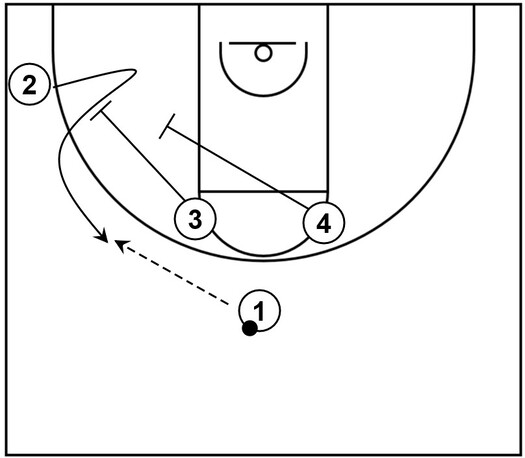
This is an example of a basic stagger screen with four offensive players on the court.
In terms of the initial setup: 1 is at the top with possession of the ball; 2 occupies the left side corner; 3 and 4 fill the left side and right side high post elbow areas, respectively.
For the action, 2 simply cuts to the left side wing via the stagger screen set by 3 and 4.
Afterwards, 2 receives the ball from 1 and has an opportunity to take the three-point shot.
Example: Basic stagger screen 2
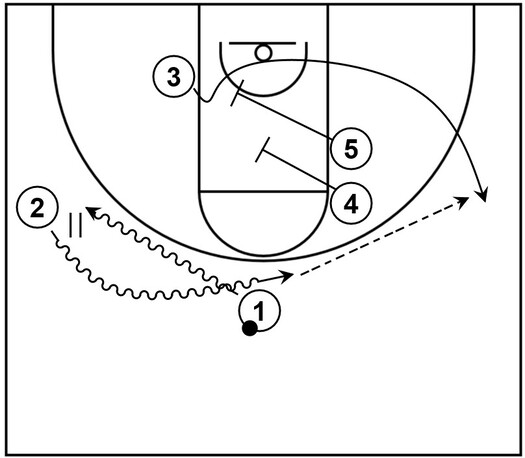
Here is another example of stagger screen action. This time, there are five offensive players on the court.
For the setup: 1 is at the top with possession of the ball; 2 fills the left side wing area; 3 fills the left side low post area; 4 and 5 occupy the right side of the lane line near the high post elbow area.
To start, 1 and 2 execute and complete dribble handoff action. Next, as 2 dribbles back towards the top, 3 cuts to the right side wing via the stagger screen set by 4 and 5.
From there, 3 receives the ball from 2 and has the opportunity to take the three-point shot.
UCLA screen
The UCLA screen occurs when an offensive player near the top or slot passes the ball to another offensive player near the adjacent wing and then a third offensive player sets a screen near the high post elbow for the offensive player who passed to the wing.
What’s more, the UCLA screen is a type of back screen. However, it is derived from the UCLA Offense, hence its name.
The diagram in the subsection below displays a basic example of the UCLA screen.
Example: Basic UCLA screen
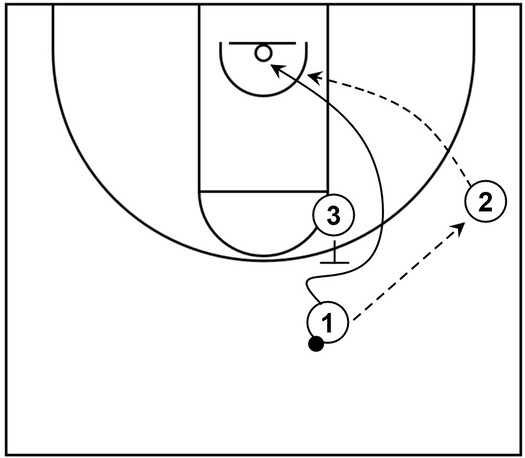
For the initial setup: 1 occupies the right slot area while in possession of the basketball; 2 fills the right side wing; 3 fills the right side high post elbow area.
To start, 2 receives the ball from 1. Afterwards, 1 cuts to the basket (also sometimes referred to as a UCLA cut) via the UCLA screen set by 3.
From there, 1 receives the ball again from 2 and scores via a layup at the rim.
Additional off-ball screen concepts to consider
This section contains additional off-ball screen concepts to consider for offensive players who would be involved in those screens.
It should be noted as well that during the off-ball screening action, the offensive player who set the screen could be referred to as the screener. Moreover, the defensive player who guards the offensive screening player could be referred to as the screener’s defender.
Types of offensive players who would typically set off-ball screens
Generally speaking, most off-ball screens are usually set by players who typically play post-oriented basketball positions such as the power forward or center.
However, it is possible for offensive players who typically play perimeter-oriented positions such as the point guard, shooting guard, or small forward to set screens as well.
That would commonly happen with basketball offense strategies such as the 5 out motion offense, the Flex offense, or the Swing offense, which generally offers equal opportunities to score for all offensive players on the court.
General offensive actions after setting an off-ball screen
Generally speaking, after setting an off-ball screen, the screener could fill the adjacent open spot, use an off-ball screen that is set by another offensive player, or even set another off-ball screen following the initial one.
Furthermore, in some instances, the screener could slip to the basket prior to that screen being completely set.
Fill the adjacent open spot
The screener could fill and replace at the adjacent open spot on the court that was previously occupied by the recipient of the screen.
This could be useful if the screener happens to be a perimeter-oriented player or if the screener possesses a perimeter shooting ability, notably from three-point range.
This is also beneficial in general because it promotes good basketball spacing on the court.
Basically, when the recipient of the off-ball screen cuts to the basket or to another area of the court near the perimeter, the screener would automatically be at least 12 to 15 feet away from them after filling the adjacent open spot.
Use an off-ball screen
The offensive player who set the screen could thereafter use an off-ball screen as well, which is generally known as screen the screener action.
This could be favorable for the offensive team because it essentially forces the defensive team to cover at least two screening actions, which could be very difficult in terms of limiting or preventing offensive scoring opportunities.
Set another off-ball screen
In certain set plays or strategies, the screener could immediately set another off-ball screen following the first one.
For example, it is possible for screeners to set a stagger screen for one particular offensive player and then immediately set a second stagger screen for a different offensive player.
As another example, a screener might set a back screen for a teammate cutting to the basket but then quickly set a down screen for that same teammate, cutting back towards the perimeter.
General offensive actions after using an off-ball screen
Generally speaking, an offensive player who would use the off-ball screen could then cut to the basket, cut to an area near the perimeter, set an on-ball screen, or set an off-ball screen.
Cut to the basket
An offensive player who uses an off-ball screen could simply cut to the basket because of the screening action itself or in certain instances, as a counter if the defender attempts to take away the initial pathway towards the perimeter areas of the court.
Cut towards perimeter areas of the court
An offensive player who uses an off-ball screen could cut to a perimeter area of the court, particularly the wings or towards the top, based on the specific screening action that occurs.
Set an on-ball screen
In certain instances, an offensive player who uses an off-ball screen could then set an on-ball screen for another player in possession of the basketball.
When this occurs, the first off-ball screen is generally referred to as a ram screen and it could be utilized as a counter to pick and roll defensive tactics, especially the defensive hedge.
Set an off-ball screen
In some cases, an offensive player who uses an off-ball screen could then set an off-ball screen themselves, particularly for the initial screener.
For example, an offensive player could initially use a down screen and cut towards the perimeter such as the wing.
However, that initial down screen action could be implemented as a decoy or as a counter to defensive tactics such as switching or shooting the gap.
Following that, the offensive player that initially used the down screen could flip it and set a down screen themselves for the initial screener, which happens to be screen the screener action as well.
These two screening actions (which are both down screens, in this example) would be very challenging for the defensive team to cover effectively. As a result, a scoring opportunity could be potentially generated for the offensive team.
General defensive actions to potentially hinder effectiveness of the off-ball screen
In general, defenders will usually attempt to hinder the effectiveness of the off-ball screen by fighting over the top of it, going under it, or executing a defensive switch.
Fight over the top
Generally speaking, a defender might choose to fight over the top of an off-ball screen if they believe that it is possible to get around it with minimal effort.
Also, a defender may attempt to fight over the top of the screen if they can see it in advance before being blocked by the screener.
Furthermore, a defender might decide to fight over the top of the screen if the offensive player that they are currently guarding is a scoring threat and the defender wants to keep as much defensive pressure as possible on that same offensive player.
Go under
A defender may decide to go under certain types of off-ball screens, ultimately to limit or prevent scoring opportunities, especially from the mid-range or three-point range of the offensive player who would be the recipient of the screen.
Going under the screen could, at least in theory, make it more difficult for the recipient of the screen to get open and quickly score, especially near perimeter areas of the court.
Nevertheless, the primary downside of going under screens is that the defender momentarily releases pressure, which then gives the recipient of the screen an opportunity to potentially counter it.
Perform defensive switching
A defender who is the target of an off-ball screen could also execute a defensive switch with another defender, particularly the screener’s defender.
That is, instead of fighting over the top of the screen or going under it, the primary defender would switch onto the screener while the secondary defender, usually the screener’s defender would switch onto the offensive player who would be the recipient of the screen.
As a simple example, if the primary defender is being targeted by a back screen, then the screener’s defender could switch unto the offensive player initially near the perimeter that would use that screen.
At the same time, the primary defender would switch onto the offensive player that set the screen.
As a result, at least theoretically, the back screen would become ineffective because the offensive player who was the recipient of the screen would not be open to score near the basket due to the quick switching action by the two defenders.
It should also be stated that switching has at least one noteworthy drawback, which is the potential creation of defensive mismatches.
Using the back screen example again, let’s say that the offensive player who set the screen is a perimeter-oriented player alongside the defender who is guarding them.
Furthermore, let’s say that the offensive player who would be the recipient of the screen is a post-oriented player.
From there, if the screener’s defender (i.e. a perimeter-oriented defender in this scenario) switches onto the offensive player cutting to the basket via the back screen, then that would result in a defensive mismatch.
That is, the perimeter-oriented screener’s defender would have a size disadvantage against the post-oriented screen recipient who would also be near the basket after the back screen action.
Simply put, for this case, the switching action would be ineffective at best or totally pointless altogether because the post-oriented player could still receive the ball near the basket and score, primarily due to their size and/or height advantage.